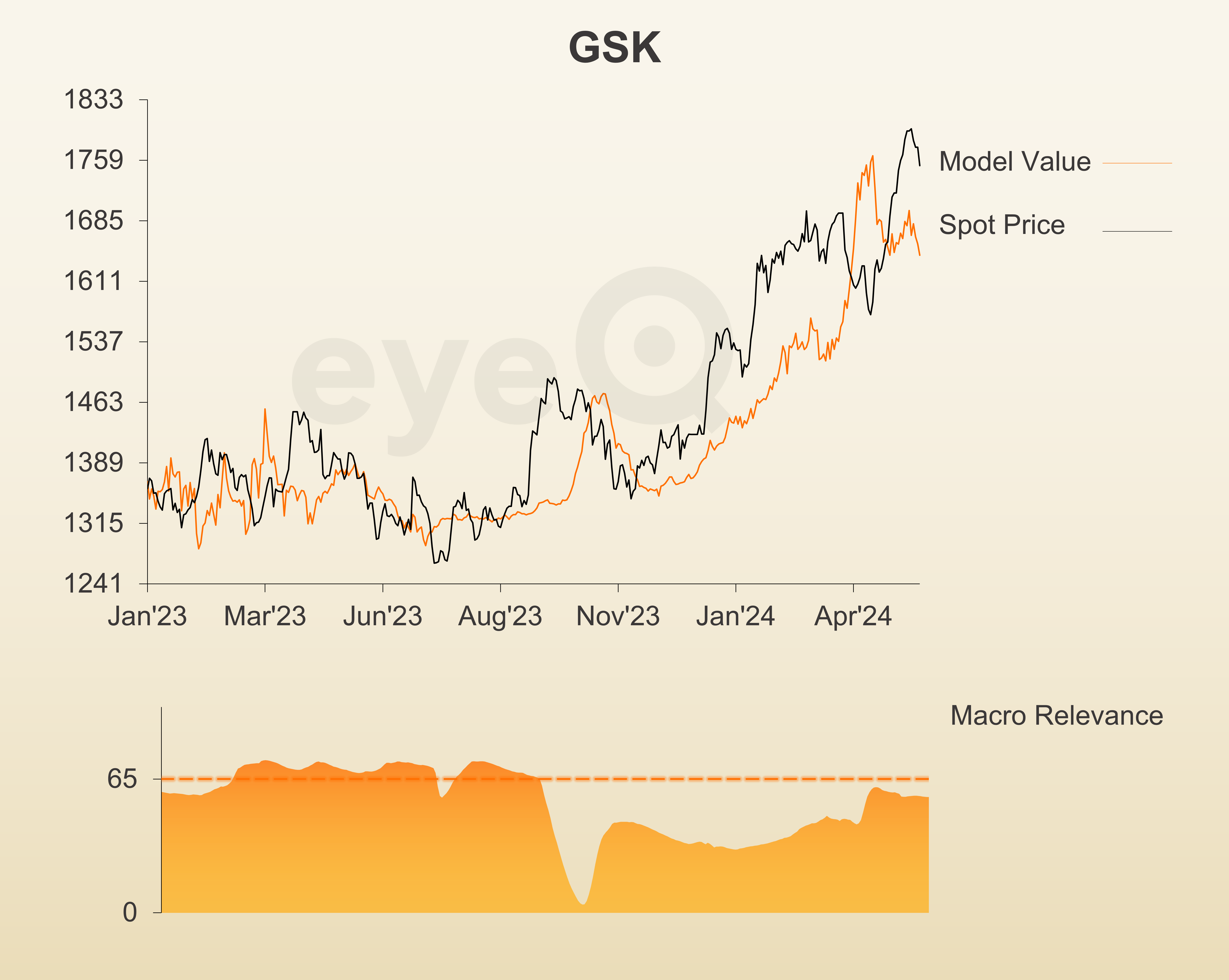eyeQ: GSK, Astra and the battle of big pharma
interactive investor has teamed up with the experts at eyeQ who use artificial intelligence and their own smart machine to analyse macro conditions and generate actionable trading signals. This time it analyses the UK drug giants.
21st May 2024 11:58
by Huw Roberts from eyeQ

"Our signals are crafted through macro-valuation, trend analysis, and meticulous back-testing. This combination ensures a comprehensive evaluation of an asset's value, market conditions, and historical performance." eyeQ
- Discover: eyeQ analysis explained | eyeQ: our smart machine in action | Glossary
GSK
Trading signal: long-term strategic model
Model value:1,643.03p
Fair Value Gap: +6.24% premium to model value
Model relevance: 56%
AstraZeneca
Trading signal: long-term strategic model
Model value:11,748.15p
Fair Value Gap: +3.59% premium to model value
Model relevance: 60%
Data correct as at 21 May 2024. Please click glossary for explanation of terms.
GSK’s share price rallied around 14.5% between mid-April and mid-May. That could be the market pre-empting good news around their new asthma drug depemokimab. GSK (LSE:GSK) just announced the drug showed good results, reducing asthma attacks in late-stage trials; a market Glaxo believes could exceed £3 billion in sales.
Developments around a new drug pipeline are always critical for pharmaceutical companies but, with eyeQ’s smart machine showing macro relevance of 56%, the stock is especially sensitive to company news right now. In fact, GSK hasn’t been driven by macro forces for nearly a year now.
Still, even with that health warning, it is worth checking in with the big picture backdrop for GSK. And currently there’s a word of warning. Aggregate macro conditions have been moving in the opposite direction over the last month, falling 1.4%. That leaves GSK 6.24% rich to the macro environment. That’s not enough to trigger a bearish signal, but these aren’t great entry levels.
The stock is an interesting mix. Rate cuts from the Bank of England should help, so would stronger economic growth. But it also has some defensive properties – it benefits when markets are trading “risk off”. That could speak to the appeal coming from GSK’s traditional role as a strong dividend payer.
Those dividend payments make GSK a perennial retail favourite (even if they aren’t what they were). But it’s worth monitoring model value to look out for any signs of improvement in the macro backdrop.

Source: eyeQ. Past performance is not a guide to future performance.
Finally, note fellow big pharma stock AstraZeneca (LSE:AZN) looks similar on eyeQ.
Macro relevance is 60%, so slightly below our threshold for a regime, and it’s slightly rich (3.59%) to macro conditions.
The big difference though is macro conditions are improving for Astra. Model value has risen 9.2% in the last month. So again, not the best entry levels, but at least a healthy uptrend in macro conditions.

Source: eyeQ. Past performance is not a guide to future performance.
Useful terminology:
Model value
Where our smart machine calculates that any stock market index, single stock or exchange-traded fund (ETF) should be priced (the fair value) given the overall macroeconomic environment.
Model (macro) relevance
How confident we are in the model value. The higher the number the better! Above 65% means the macro environment is critical, so any valuation signals carry strong weight. Below 65%, we deem that something other than macro is driving the price.
Fair Value Gap (FVG)
The difference between our model value (fair value) and where the price currently is. A positive Fair Value Gap means the security is above the model value, which we refer to as “rich”. A negative FVG means that it's cheap. The bigger the FVG, the bigger the dislocation and therefore a better entry level for trades.
Long Term model
This model looks at share prices over the last 12 months, captures the company’s relationship with growth, inflation, currency shifts, central bank policy etc and calculates our key results - model value, model relevance, Fair Value Gap.
These third-party research articles are provided by eyeQ (Quant Insight). interactive investor does not make any representation as to the completeness, accuracy or timeliness of the information provided, nor do we accept any liability for any losses, costs, liabilities or expenses that may arise directly or indirectly from your use of, or reliance on, the information (except where we have acted negligently, fraudulently or in wilful default in relation to the production or distribution of the information).
The value of your investments may go down as well as up. You may not get back all the money that you invest.
Equity research is provided for information purposes only. Neither eyeQ (Quant Insight) nor interactive investor have considered your personal circumstances, and the information provided should not be considered a personal recommendation. If you are in any doubt as to the action you should take, please consult an authorised financial adviser.
Disclosure
We use a combination of fundamental and technical analysis in forming our view as to the valuation and prospects of an investment. Where relevant we have set out those particular matters we think are important in the above article, but further detail can be found here.
Please note that our article on this investment should not be considered to be a regular publication.
Details of all recommendations issued by ii during the previous 12-month period can be found here.
ii adheres to a strict code of conduct. Contributors may hold shares or have other interests in companies included in these portfolios, which could create a conflict of interests. Contributors intending to write about any financial instruments in which they have an interest are required to disclose such interest to ii and in the article itself. ii will at all times consider whether such interest impairs the objectivity of the recommendation.
In addition, individuals involved in the production of investment articles are subject to a personal account dealing restriction, which prevents them from placing a transaction in the specified instrument(s) for a period before and for five working days after such publication. This is to avoid personal interests conflicting with the interests of the recipients of those investment articles.